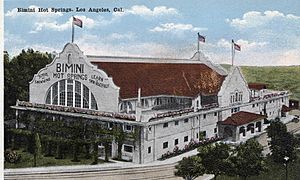Bimini Baths facts for kids
The Bimini Baths was a popular public bathhouse in Koreatown, Los Angeles, California. It was also known as the Bimini Hot Springs and Sanitarium. This special place used natural hot spring water from deep underground. It had swimming pools, a large swimming area, and even Turkish baths. People could also get medical treatments there. Today, the area is a park called Bimini Slough Ecology Park.
History of Bimini Baths
In the 1800s, the land where Bimini Baths was built was a big marsh, about 45 acres in size. Underneath this marsh were natural hot springs with water as warm as 104°F (40°C)! These hot springs were found by accident. A man was drilling for oil very deep, about 1,750 feet down, when he hit the warm water.
The baths were named after the island of Bimini in The Bahamas. Dr. David W. Edwards owned and ran the Bimini Water Company, which opened the bathhouse on December 31, 1902. The bathhouse itself opened in 1903. A year later, the Bimini Hotel was built across the street, and the hot spring water was pumped over to it. In 1921, a new outdoor pool was added to the baths.
Sadly, not everyone was treated fairly at the baths. Some groups of people were only allowed to use the baths at certain times, which wasn't right.
Besides the baths, the Bimini Water Company also delivered plain and fizzy water to homes in Los Angeles. This was before the city had its own water pipes in 1915. The business eventually closed down in 1951, and the buildings were taken down in 1956. Today, the hot springs area is a nature park with native plants and a small creek. The old hotel building is now used by the Mary Lind Foundation.
The Special Hot Springs Water
The well at Bimini Baths could bring up 100 gallons of water every minute, all at a warm 104°F (40°C). The water felt very soft and smooth, which is why people called it "the velvet baths." This special water came from 1,750 feet deep underground.
The water didn't have any sulfur, which can sometimes make hot springs smell like rotten eggs. Instead, it had a lot of sodium carbonate and sodium chloride (which is common salt). It also contained small amounts of other minerals like potassium, magnesium, iron, and aluminum.
Buildings and Features
The original Bimini Baths building was made of wood. It had a very long main pool, about 50 yards long, and a separate pool just for women. There were also smaller, private pools. Visitors could enjoy a cafe, watch people swim from a balcony, and use one of 500 dressing rooms.
Sadly, the first building was destroyed by a fire in 1905. But it was quickly rebuilt in 1906! The new building was designed in a beautiful style called Mission Revival. This new version had a Turkish bath, even more pools, and gardens on the roof. There was also a sanitarium, which was like a health center, connected to the baths. People could enjoy tub baths and three large swimming areas. A hotel nearby was also managed by the same company.
 This article incorporates text from a work in the public domain: G. Waring's "Water-supply Paper" (1915)
This article incorporates text from a work in the public domain: G. Waring's "Water-supply Paper" (1915)


